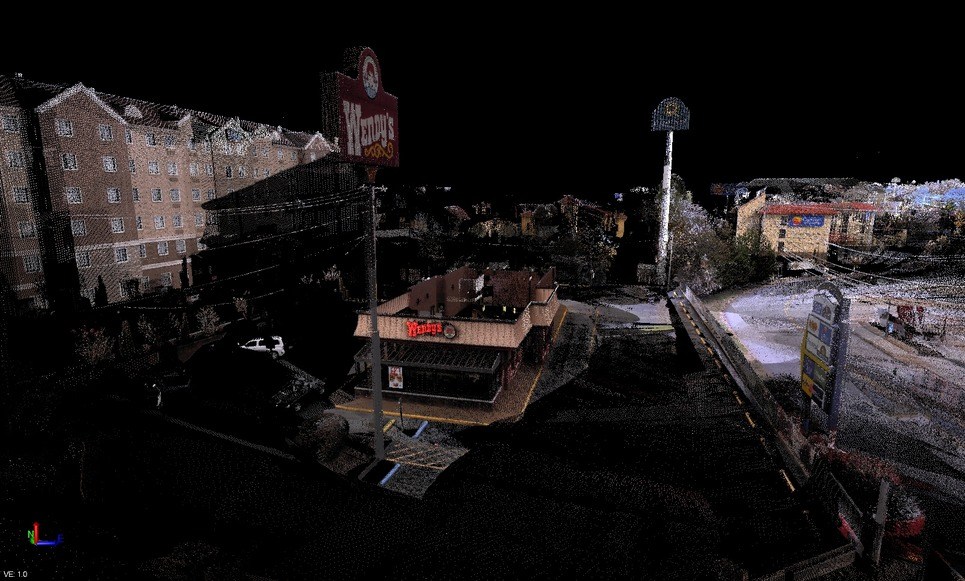I’m back in Vegas baby! For a guy who doesn’t enjoy gambling and thinks that the only thing in Vegas worth seeing is Frankie’s Tiki Room, I sure seem to spend a lot of time here.
This time around I attended the 2018 Trimble Dimensions Conference at the Venetian. I must admit that this is the first Dimensions conference that I have attended—Though I started my mapping career with Trimble GPS equipment (and GPSurvey, if you’re trying to guess how old I am), I migrated to other manufacturers as I began laser scanning. However, last year my team purchased Trimble gear for our survey crews, so I decided I needed to get a better understanding of the entire ecosystem.
Format-wise, Dimensions falls somewhere between HxGN Live and Autodesk University. It’s all Trimble on the exhibit floor, excepting booths for a few 3rd party vendors, but the focus is on the class presentations which require sign up in advance. Like all user conferences, it’s more about learning very specific skills and networking technician to technician than it is about business development. As such, my experience was rooted in the subjects that I needed addressed and I’ve no doubt that a person choosing different classes would have a very different experience. The classes ranged from augmented reality (where I was), to agricultural machine control programming (where I was not).
Without further ado, here are my takeaways from 2018’s Trimble Dimensions:
It’s all new to me!
That goes for hardware, software, and people. I go to a fair number of conferences, and out of the 4,500 or so attendees, I only ran into 10-15 that I knew. I guess I’ve been shortchanging the Trimble booth at SPAR, since I only knew about the hardware that we own. This means I saw a lot of hardware and software at Dimensions that we will probably not ever use (agriculture, first responder, marine, etc.), but it also means I found a lot of useful software I was unaware of. I like this.
In retrospect, having to sign up for classes in advance nudged me to pick too many classes that were similar to one another in content, but it also allowed me to get a handle on which other attendees were in all of the same classes I was in. That certainly made it easy to begin developing a list of “go to” contacts when I need assistance with Trimble-related questions in the future.
 Mixed Reality was a hot topic
Mixed Reality was a hot topic
Trimble was the first through the gate when the HoloLens was released with their Trimble Connect for HoloLens, and they don’t seem to be slowing down. As far as I can tell, Trimble has multiple groups working on virtual reality and mixed reality applications, each group specializing in a particular market vertical.
From what I saw, Trimble appears to be the first to offer virtual reality and mixed reality viewers for their existing software suites as add-ons, as opposed to stand-alone applications. While this may not fill the needs of clients, it should provide a low-cost way for employees to collaborate on datasets in VR, or QA/QC designs in VR, without having to enlist your an in-house AR/VR dev team.
The advance version of Trimble Connect for VR also supports point clouds, which is a nice feature for those of us on the Windows Mixed Reality track, as opposed to Steam or Unreal Engine. However, I suspect that their Trimble SiteVision product might actually see the fastest adoption. It’s essentially a GPS-enabled tablet that shows augmented data in its correct location and orientation over a live camera feed from the tablet. The ability to preview designs onsite in real-time without having to use head mounted displays seems like it may present a lower barrier to adoption for many.
 Trimble Business Center is growing
Trimble Business Center is growing
The announcement was that Trimble Business Center (TBC) software suite is absorbing the Business Center HCE (Heavy Civil Edition) Suite. However, after discussing outstanding feature requests for both platforms in a beta-testers forum, it seems like it might be the other way around. The two are scheduled become one with the release of TBC 5.0 in the next “few weeks.”
Trimble is adding additional features to the 5.0 release as well, the most meaningful one for me being the changes to the Point Cloud Module. With version 5.0, the point cloud rendering looks better, and there are some powerful new feature extraction tools for converting point clouds to CAD objects. In fact, CAD integration is much more thorough with feature and line code recognition offered in order to align TBC with AutoCAD Civil3D when it comes to viewing collected data.
Drinking the Kool-Aid?
I tend to be a bit skeptical of manufacturer-specific user conferences as it sometime seems like a big commercial. I’ll have to hand it to Trimble though: As a presenter, I was never asked to avoid mentioning other manufacturers’ hardware or software, or to speak no evil about Trimble products.
Trimble has released and/or updated a lot of products in the past two years and there were times that it showed. I definitely met users that were far ahead of the Trimble employees when it came to understanding the applied uses of various products. That being said, Trimble went to great pains to show that they knew this to be the case, and that these power users are integral to Trimble’s success moving forward. I don’t think that this is very different from any other manufacturer, but it was nice to see them address it so openly.
Trimble Dimensions 2020 will be in Nashville!
Far be it from me to remind anyone in a position of scheduling authority (you know who you are…) but I have been pushing for a conference (any conference!) to give Nashville a try for years now. Dimensions only happens every two years (which isn’t a bad idea for a user conference based upon a single manufacturer, imho) so that means Nashville is actually the next location. This town is a blast, and as a resident, I can’t wait to welcome one and all when the time comes. Don’t forget to pick up your shirts at Rockmount while you’re in Denver at ILMF this January!









